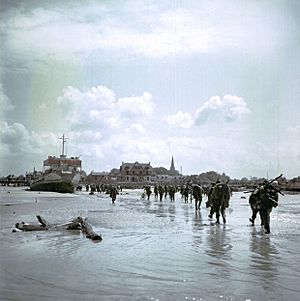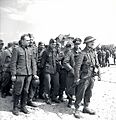Juno Beach facts for kids
Quick facts for kids Juno Beach |
|||||||
|---|---|---|---|---|---|---|---|
| Part of the Normandy landings and the Battle for Caen | |||||||
 Canadian soldiers landing at Juno on the outskirts of Bernières. |
|||||||
|
|||||||
| Belligerents | |||||||
|
|||||||
| Commanders and leaders | |||||||
| Units involved | |||||||
| Strength | |||||||
| 1 Infantry Division 1 Armoured Brigade 1 Commando Battalion |
Elements of 1 Infantry Division | ||||||
| Casualties and losses | |||||||
| 340 dead 574 wounded 47 captured |
Unknown | ||||||
Juno or Juno Beach was one of five beaches of the Allied invasion of German-occupied France in the Normandy landings on 6 June 1944 during the Second World War. The beach spanned from Courseulles, a village just east of the British beach Gold, to Saint-Aubin-sur-Mer, and just west of the British beach Sword.
Taking Juno was the responsibility of the Canadian Army, with sea transport, mine sweeping, and a naval bombardment force provided by the Royal Canadian Navy and the British Royal Navy as well as elements from the Free French, Norwegian, and other Allied navies. The objectives of the 3rd Canadian Infantry Division on D-Day were to cut the Caen-Bayeux road, seize the Carpiquet airport west of Caen, and form a link between the two British beaches on either flank.
The beach was defended by two battalions of the German 716th Infantry Division, with elements of the 21st Panzer Division held in reserve near Caen.
The invasion plan called for two brigades of the 3rd Canadian Division to land on two beach sectors—Mike and Nan—focusing on Courseulles, Bernières and Saint-Aubin. It was hoped that the preliminary naval and air bombardments would soften up the beach defences and destroy coastal strong points. Close support on the beaches was to be provided by amphibious tanks of the 2nd Canadian Armoured Brigade and specialized armoured vehicles of the 79th Armoured Division of the United Kingdom. Once the landing zones were secured, the plan called for the 9th Canadian Infantry Brigade to land reserve battalions and deploy inland, the Royal Marine commandos to establish contact with the British 3rd Infantry Division on Sword and the 7th Canadian Infantry Brigade to link up with the British 50th Infantry Division on Gold. The 3rd Canadian Division's D-Day objectives were to capture Carpiquet Airfield and reach the Caen–Bayeux railway line by nightfall.
The landings initially encountered heavy resistance from the German 716th Division; the preliminary bombardment proved less effective than had been hoped, and rough weather forced the first wave to be delayed until 07:35. Several assault companies—notably those of the Royal Winnipeg Rifles and The Queen's Own Rifles of Canada—took heavy casualties in the opening minutes of the first wave. Strength of numbers, coordinated fire support from artillery, and armoured squadrons cleared most of the coastal defences within two hours of landing. The reserves of the 7th and 8th brigades began deploying at 08:30 (along with the Royal Marines), while the 9th Brigade began its deployment at 11:40.
The subsequent push inland towards Carpiquet and the Caen–Bayeux railway line achieved mixed results. The sheer numbers of men and vehicles on the beaches created lengthy delays between the landing of the 9th Brigade and the beginning of substantive attacks to the south. The 7th Brigade encountered heavy initial opposition before pushing south and making contact with the British 50th Division at Creully. The 8th Brigade encountered heavy resistance from a battalion of the 716th at Tailleville, while the 9th Brigade deployed towards Carpiquet early in the evening. Resistance in Saint-Aubin prevented the Royal Marines from establishing contact with the British 3rd Division on Sword. By the time all operations on the Anglo-Canadian front were ordered to halt at 21:00, The Queen's Own Rifles of Canada had reached its D-Day objective and the 3rd Canadian Infantry Division had succeeded in pushing farther inland than any other landing force on D-Day.
Images for kids
-
HMS Lawford, one of several Captain-class frigates converted to act as a headquarters ship for the Normandy landings, note the extended superstructure (to accommodate the Staff Officers) and additional smaller mainmast to support the extra aerials. On 8 June 1944, whilst operating off Juno, she was hit by enemy fire during an air attack and sunk.
-
Field Marshal Erwin Rommel inspecting Atlantic Wall defences, April 1944
-
The "Canada House", on Juno Beach, Bernières-sur-Mer, during the 76th anniversary of the D-Day landings.
See also
 In Spanish: Playa de Juno para niños
In Spanish: Playa de Juno para niños













